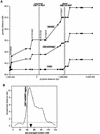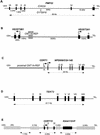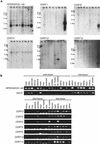The 1.4-Mb CMT1A duplication/HNPP deletion genomic region reveals unique genome architectural features and provides insights into the recent evolution of new genes
- PMID: 11381029
- PMCID: PMC311111
- DOI: 10.1101/gr.180401
The 1.4-Mb CMT1A duplication/HNPP deletion genomic region reveals unique genome architectural features and provides insights into the recent evolution of new genes
Abstract
Duplication and deletion of the 1.4-Mb region in 17p12 that is delimited by two 24-kb low copy number repeats (CMT1A-REPs) represent frequent genomic rearrangements resulting in two common inherited peripheral neuropathies, Charcot-Marie-Tooth disease type 1A (CMT1A) and hereditary neuropathy with liability to pressure palsy (HNPP). CMT1A and HNPP exemplify a paradigm for genomic disorders wherein unique genome architectural features result in susceptibility to DNA rearrangements that cause disease. A gene within the 1.4-Mb region, PMP22, is responsible for these disorders through a gene-dosage effect in the heterozygous duplication or deletion. However, the genomic structure of the 1.4-Mb region, including other genes contained within the rearranged genomic segment, remains essentially uncharacterized. To delineate genomic structural features, investigate higher-order genomic architecture, and identify genes in this region, we constructed PAC and BAC contigs and determined the complete nucleotide sequence. This CMT1A/HNPP genomic segment contains 1,421,129 bp of DNA. A low copy number repeat (LCR) was identified, with one copy inside and two copies outside of the 1.4-Mb region. Comparison between physical and genetic maps revealed a striking difference in recombination rates between the sexes with a lower recombination frequency in males (0.67 cM/Mb) versus females (5.5 cM/Mb). Hypothetically, this low recombination frequency in males may enable a chromosomal misalignment at proximal and distal CMT1A-REPs and promote unequal crossing over, which occurs 10 times more frequently in male meiosis. In addition to three previously described genes, five new genes (TEKT3, HS3ST3B1, NPD008/CGI-148, CDRT1, and CDRT15) and 13 predicted genes were identified. Most of these predicted genes are expressed only in embryonic stages. Analyses of the genomic region adjacent to proximal CMT1A-REP indicated an evolutionary mechanism for the formation of proximal CMT1A-REP and the creation of novel genes by DNA rearrangement during primate speciation.
Figures






Similar articles
-
Charcot-Marie-Tooth disease and related inherited neuropathies.Medicine (Baltimore). 1996 Sep;75(5):233-50. doi: 10.1097/00005792-199609000-00001. Medicine (Baltimore). 1996. PMID: 8862346 Review.
-
Novel PCR-based diagnostic tools for Charcot-Marie-Tooth type 1A and hereditary neuropathy with liability to pressure palsies.J Peripher Nerv Syst. 1999;4(2):117-22. J Peripher Nerv Syst. 1999. PMID: 10442687
-
Recombination hot spot in a 3.2-kb region of the Charcot-Marie-Tooth type 1A repeat sequences: new tools for molecular diagnosis of hereditary neuropathy with liability to pressure palsies and of Charcot-Marie-Tooth type 1A. French CMT Collaborative Research Group.Am J Hum Genet. 1996 Jun;58(6):1223-30. Am J Hum Genet. 1996. PMID: 8651299 Free PMC article.
-
Two autosomal dominant neuropathies result from reciprocal DNA duplication/deletion of a region on chromosome 17.Hum Mol Genet. 1994 Feb;3(2):223-8. doi: 10.1093/hmg/3.2.223. Hum Mol Genet. 1994. PMID: 8004087
-
Molecular mechanisms for CMT1A duplication and HNPP deletion.Ann N Y Acad Sci. 1999 Sep 14;883:22-35. Ann N Y Acad Sci. 1999. PMID: 10586226 Review.
Cited by
-
Comparative genomic hybridisation using a proximal 17p BAC/PAC array detects rearrangements responsible for four genomic disorders.J Med Genet. 2004 Feb;41(2):113-9. doi: 10.1136/jmg.2003.012831. J Med Genet. 2004. PMID: 14757858 Free PMC article.
-
Evidence for involvement of TRE-2 (USP6) oncogene, low-copy repeat and acrocentric heterochromatin in two families with chromosomal translocations.Hum Genet. 2006 Sep;120(2):227-37. doi: 10.1007/s00439-006-0200-7. Epub 2006 Jun 22. Hum Genet. 2006. PMID: 16791615
-
Genetics of Charcot-Marie-Tooth (CMT) Disease within the Frame of the Human Genome Project Success.Genes (Basel). 2014 Jan 22;5(1):13-32. doi: 10.3390/genes5010013. Genes (Basel). 2014. PMID: 24705285 Free PMC article.
-
Genetic proof of unequal meiotic crossovers in reciprocal deletion and duplication of 17p11.2.Am J Hum Genet. 2002 Nov;71(5):1072-81. doi: 10.1086/344346. Epub 2002 Oct 9. Am J Hum Genet. 2002. PMID: 12375235 Free PMC article.
-
Evolution in health and medicine Sackler colloquium: Genomic disorders: a window into human gene and genome evolution.Proc Natl Acad Sci U S A. 2010 Jan 26;107 Suppl 1(Suppl 1):1765-71. doi: 10.1073/pnas.0906222107. Epub 2010 Jan 13. Proc Natl Acad Sci U S A. 2010. PMID: 20080665 Free PMC article. Review.
References
-
- Badano, J.L., Inoue, K., Katsanis, N., and Lupski, J.R. New polymorphic short tandem repeats for PCR-based Charcot-Marie-Tooth disease type 1A duplication diagnosis. Clin. Chem. (In press). - PubMed
-
- Blair IP, Kennerson ML, Nicholson GA. Detection of Charcot-Marie-Tooth type 1A duplication by the polymerase chain reaction. Clin Chem. 1995;41:1105–1108. - PubMed
-
- Boerkoel CF, Inoue K, Reiter LT, Warner LE, Lupski JR. Molecular mechanisms for CMT1A duplication and HNPP deletion. Ann NY Acad Sci. 1999;883:22–35. - PubMed
-
- Chance PF, Alderson MK, Leppig KA, Lensch MW, Matsunami N, Smith B, Swanson PD, Odelberg SJ, Disteche CM, Bird TD. DNA deletion associated with hereditary neuropathy with liability to pressure palsies. Cell. 1993;72:143–151. - PubMed
Publication types
MeSH terms
Substances
Grants and funding
LinkOut - more resources
Full Text Sources
Other Literature Sources
Medical
Molecular Biology Databases
Miscellaneous
